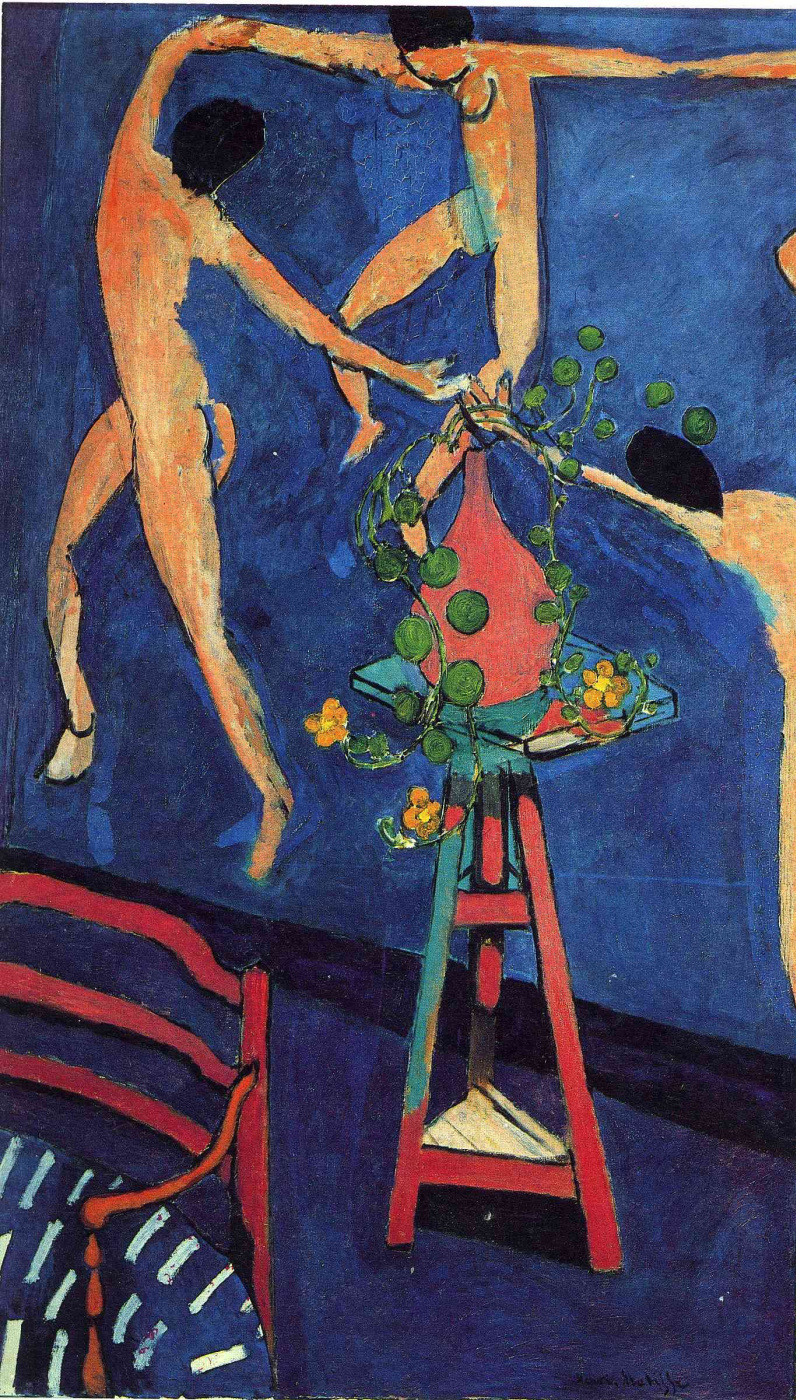log in
Enter site
Login to use Arthive functionality to the maximum
Nasturtiums. Panel The Dance
Henri Matisse • Painting, 1912, 193×114 cm
Description of the artwork «Nasturtiums. Panel The Dance»
Matisse's work Nasturtiums with The Dance is a picture within a picture, as the title implies. This is not the first time when The Dance acts as a guest star in other paintings of the artist: he used the same trick with The Pink Studio painting. But if in that picture we see only a small fragment of the panel, as a logical and expected element of the artist's studio environment, in the case of Nasturtiums, the panel Dance plays a major role, paradoxically obscuring the vase with the flower in the foreground.
This amazing work is a good example of Matisse's talent. Not particularly outstanding from a technical point of view, the brushstrokes on it are very careless, especially in the detail of The Dance which looks more like the preliminary sketch than a study (next to the figures of the dancers it is easy to see their original outlines, which the artist did not really bother to paint over). But look at the lines of the chair and the stand under the flower, which obey the solely Matisse's perspective... or at the geometry of rhyming diagonals, or else at a glaring lack of volume of the vase and the flower itself! All this creates a magnetic effect and makes you think of the reasons for attraction over and over again.
A poor set of colors seems to have been intended to illustrate Matisse's postulate of colors: "The starting point of Fauvism," he wrote, "is a call for beautiful blues, reds, yellows – matter to stir the sensual depths in men." Although Nasturtiums can only be conditionally attributed to Fauvism, just due to the frantic brushstrokes in the area of The Dance, the second part of the statement is convincingly confirmed by the picture.
The critic Jacob Tugendhold also fell under its charm and compared a picturesque effect of Matisse's works with the shining of stained-glass windows and mosaics in cathedrals and basilicas. "This becomes especially clear when you first glimpse from the doorway of Shchukin's drawing room Nasturtiums and The Dance and The Conversation, the orange and pink bodies of the former flare out from their blue ground like arabesques of glass," wrote the art historian, "Look at Gauguin's paintings, and then back at Matisse's Nasturtiums: the former will seem like a matt fresco, the latter more like a translucent stained-glass window. Matisse's palette is richer, more complex and grander than Gauguin's. Matisse is the greatest colourist of our time, and the most cultivated: he has absorbed into himself all the luxury of the East and Byzantium.
Author: Natalia Azarenko
This amazing work is a good example of Matisse's talent. Not particularly outstanding from a technical point of view, the brushstrokes on it are very careless, especially in the detail of The Dance which looks more like the preliminary sketch than a study (next to the figures of the dancers it is easy to see their original outlines, which the artist did not really bother to paint over). But look at the lines of the chair and the stand under the flower, which obey the solely Matisse's perspective... or at the geometry of rhyming diagonals, or else at a glaring lack of volume of the vase and the flower itself! All this creates a magnetic effect and makes you think of the reasons for attraction over and over again.
A poor set of colors seems to have been intended to illustrate Matisse's postulate of colors: "The starting point of Fauvism," he wrote, "is a call for beautiful blues, reds, yellows – matter to stir the sensual depths in men." Although Nasturtiums can only be conditionally attributed to Fauvism, just due to the frantic brushstrokes in the area of The Dance, the second part of the statement is convincingly confirmed by the picture.
The critic Jacob Tugendhold also fell under its charm and compared a picturesque effect of Matisse's works with the shining of stained-glass windows and mosaics in cathedrals and basilicas. "This becomes especially clear when you first glimpse from the doorway of Shchukin's drawing room Nasturtiums and The Dance and The Conversation, the orange and pink bodies of the former flare out from their blue ground like arabesques of glass," wrote the art historian, "Look at Gauguin's paintings, and then back at Matisse's Nasturtiums: the former will seem like a matt fresco, the latter more like a translucent stained-glass window. Matisse's palette is richer, more complex and grander than Gauguin's. Matisse is the greatest colourist of our time, and the most cultivated: he has absorbed into himself all the luxury of the East and Byzantium.
Author: Natalia Azarenko


